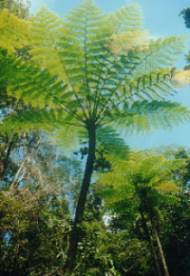Scaly Tree Fern

Photo: Courtesy of Damon Ramsey
Scaly Tree Fern: Cyanthea cooperi The most commonly seen tree fern at Chambers Wildlife Rainforest Lodges . There are seven species of tree ferns in the Wet Tropics, three of them endemic. Although all seven are found in the uplands, only two, the scaly, or Cooper’s, tree fern (Cyanthea cooperi) and black tree fern (Cyanthea rebeccae) are found in the tropical lowlands. The most common and most widespread, the scaly tree fern, is also the largest, growing to a height of 15m with a 30 cm thick trunk. The trunk is patterned with large oval scars left by fallen fronds. It is hardy and often grown in gardens. Unlike conifers and other advanced trees, tree ferns are not capable of producing secondary timber. This means that their trunks cannot become thicker, growth occurring only from the top. The trunk is pithy on the inside but hard on the outside and is often covered with a mass of tough aerial roots. If the tree fern is knocked over these can grow into the ground and develop as normal roots.
Courtesy of: Environmental Protection Agency, Cairns. Also known as the ‘Scaly tree fern’, it is characterized by the following: Trunk up to 15 cm in diameter and to 12 m or more tall, thickened at the base and patterned throughout with large oval, clean-cut scars left by fallen fronds. Stipe bases brown, tuberculate, covered by long, white and short, red-brown scales. Fronds up to 6 m long, green above, paler beneath. Sori orbicular, surrounded by circular indusia, each made up of scales. It is a very handsome, fast-growing species, which is extremely popular in cultivation. The apex of the trunk and unfurling crosiers are particularly attractive, covered as they are with conspicuous long, silky, white scales. Specimens from northern Queensland have less persistent scales. Some extremely robust specimens are occasionally encountered in north-eastern Qld. These closely resemble the Norfolk Island C. brownii in all respects.
Confusing species: Distinguishing Features: Distribution: Qld (from Cooktown South), NSW (as far South as the Illawarra district). Naturalized in WA (Bedfordale).
Cultivation: Jones. D.L, Clemesha. S.C., Australian Ferns and Fern Allies, 1980
Additional Information: Damon Ramsey Tree Ferns:
Amongst the prettiest of ferns are the 'tree ferns' belonging to several different families, but mainly Cyatheaceae in the coastal lowlands. They are true ferns that grow a single tall stalk, like a tree, thus the common name. Being attractive means they often serve as a symbol for the tropical rainforests around the world, but can in fact be just as common in the cooler subtropical and temperate rainforests of the southern hemisphere.
Most of the tree ferns around the warmer coastal lowlands will belong to the genus Cyathea, with 'Rebecca's Tree Fern', Cyathea rebeccae being particularly common. This rather thin tree fern often retains the old branches that hang down as thin brown straps underneath the current green fronds. Script: Courtesy of Damon Ramsey BSc.(Zool) Biologist Guide Additional Scaly Tree Fern Photos
Additional Scaly Tree Fern Photo 2
Additional Scaly Tree Fern Photo 3 |
